Winter Riding Maintenance Tips
So, it is a busy time of year in the workshop. It’s that time of year when I find a lot of seized parts and rough bearings. Hopefully you’ve managed to get bit of outdoor riding in over the Christmas and New Year break, despite the damp, miserable, wet, cold, misty conditions. I did and it got me thinking when I saw other riders out there and started getting more repairs in, whatever happened to traditional winter bikes.
Puncture Resistance
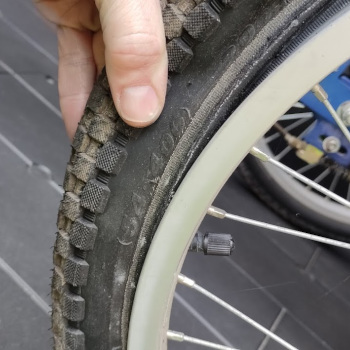 You know a heavier metal frame with long drop rim brakes, mudguards and cheaper 8 or 9 speed groupsets with more puncture resistant, slower training tyres. I ride around now, and I see lots of riders with high end, carbon fibre bikes with deep carbon rims, lightweight tyres and no mudguards (they’re not fenders). Fair enough if you’ve got the cash to be able to afford to maintain these high-end bikes but surely this time of year isn’t about setting your Strava segment KOMS, it should be about building up your winter base mileage and stripping down and servicing your best summer bike!
You know a heavier metal frame with long drop rim brakes, mudguards and cheaper 8 or 9 speed groupsets with more puncture resistant, slower training tyres. I ride around now, and I see lots of riders with high end, carbon fibre bikes with deep carbon rims, lightweight tyres and no mudguards (they’re not fenders). Fair enough if you’ve got the cash to be able to afford to maintain these high-end bikes but surely this time of year isn’t about setting your Strava segment KOMS, it should be about building up your winter base mileage and stripping down and servicing your best summer bike!
Who wants to be stood at the side of the road trying to fix a puncture in these cold conditions just because they were using a lightweight, low rolling resistance summer tyre to go a bit faster on wet and slippery roads?. A more puncture proof winter training tyre will keep you warmer, wear better and be more grippy and therefore safer too.
Seized Bearings and Corroded Parts
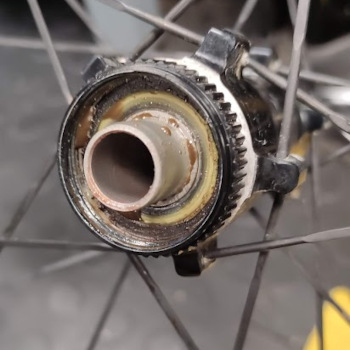 Typically, this time of the year I see a lot of seized bearings and corroded parts. Often it can be a headache stripping the problem part down to maintain it because it won’t come apart. I’ve had plenty of freehubs in this last month or so requiring the bearings changing. Often the cyclist bringing the bike into me isn’t even aware they’ve got a problem. It seems people don’t take the wheels out of their frames at all now to inspect them. Removing the wheel and a quick spin of the axles to see how smooth the bearings are can let you know that everything is OK.
Typically, this time of the year I see a lot of seized bearings and corroded parts. Often it can be a headache stripping the problem part down to maintain it because it won’t come apart. I’ve had plenty of freehubs in this last month or so requiring the bearings changing. Often the cyclist bringing the bike into me isn’t even aware they’ve got a problem. It seems people don’t take the wheels out of their frames at all now to inspect them. Removing the wheel and a quick spin of the axles to see how smooth the bearings are can let you know that everything is OK.
Another typical issue I come to are stuck through axles. You turn the through axle and the thread undoes from the frame but the through axle won’t slide out. This is where the through axle has stuck to the hub axle. It’s probably that salty road runoff has found its way inside and they’ve corroded or stuck together. What would help here is a thin smear of grease across the through axle (I don’t mean the threads) before installing the wheel into the frame. Most new bikes I build out the box arrive with clean, dry through axles.
Headset Bearings
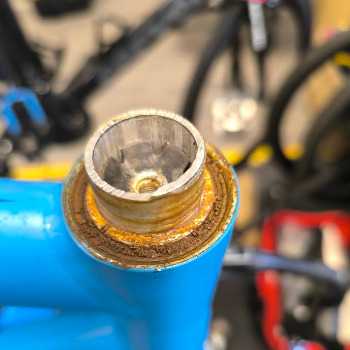 Another area where I see regular failures are the headset bearings particularly the lower set. This used to be a pretty quick 20 minute job to sort out by cleaning out and replacing the headset bearing. However, with the advent of integrated cockpits and hydraulic disc brake hoses that run inside handlebars to save a tiny bit of aerodynamic drag (and maybe look nice) this can turn into a few hours labour putting the cost up significantly. This is another reason why I wouldn’t be using a lightweight racing bike through the winter months. The cost of parts to replace them as they get worn out in the harsh conditions in my opinion is excessive particularly when there is no need for a competitive racing advantage.
Another area where I see regular failures are the headset bearings particularly the lower set. This used to be a pretty quick 20 minute job to sort out by cleaning out and replacing the headset bearing. However, with the advent of integrated cockpits and hydraulic disc brake hoses that run inside handlebars to save a tiny bit of aerodynamic drag (and maybe look nice) this can turn into a few hours labour putting the cost up significantly. This is another reason why I wouldn’t be using a lightweight racing bike through the winter months. The cost of parts to replace them as they get worn out in the harsh conditions in my opinion is excessive particularly when there is no need for a competitive racing advantage.
Whilst I’m talking about headsets a quick way to check your headset condition is to lift the front wheel off the ground and just rotate the handlebars to see how smooth it is. If it is rough, noisy or difficult to turn, chances are it needs some maintenance. Another test is to apply the front brake, place one hand over where the fork enters the inside of the head tube and rock the bike backwards and forwards. If you can feel any movement or knocking here, again it’s probably a sign that the bearing either needs adjusting or has worn out.
For modern bikes where the headset bearing runs directly on the carbon of the fork, this needs fixing straight away as every pot hole that you hit and road vibration are causing the bearing to rub and wear away the place that they are sitting on the fork, potentially damaging the fork. Now that would be a very costly replacement.
Hydraulic Disc Brakes – Winter Riding Maintenance
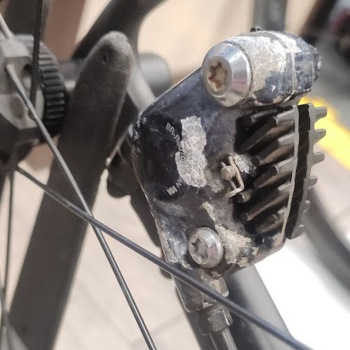 I have mixed feelings about using hydraulic disc brakes for winter riding. Their power is undeniably great and their modulation in wet slippery conditions very helpful. However, there are a couple of issues that regularly occur 1) they can squeal and howl terribly to the point it puts you off using them 2) for the rider who isn’t given to checking their bike on a regular basis, the pads are hidden from view. I regularly receive bikes where the metal backing of the pads is in contact with the disc rotors instead of the resin pad which has worn away. Again, another expensive part replacement bill if the rotors are knackered too.
I have mixed feelings about using hydraulic disc brakes for winter riding. Their power is undeniably great and their modulation in wet slippery conditions very helpful. However, there are a couple of issues that regularly occur 1) they can squeal and howl terribly to the point it puts you off using them 2) for the rider who isn’t given to checking their bike on a regular basis, the pads are hidden from view. I regularly receive bikes where the metal backing of the pads is in contact with the disc rotors instead of the resin pad which has worn away. Again, another expensive part replacement bill if the rotors are knackered too.
A further issue I tend to find with disc brakes, particularly those that are used through the winter months, is that the pad retaining pin can seize in place. It’s not a problem with split pin pad retainers but with those pins that have a threaded end that engages with the caliper they can get stuck in place. This is where things can get difficult and expensive given the labour time to either split apart the calliper, if possible, or drill out and risk damaging the caliper, whilst trying to remove the pin to replace the pads. In the worst instance we need to replace the caliper and bleed the brakes.
Given recent part supply issues sometimes it can be months before replacement callipers are available. Far better to regularly remove the pad retaining pin and apply some copper slip to the threaded area (nowhere near your brake pads though) to hopefully try and stop the seizing issue.
Do you run tubeless tyres?
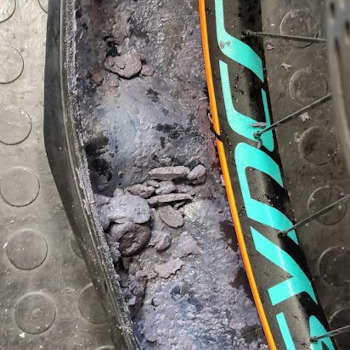 The winter is definitely the time to check on the state of any sealant particularly if you really must run lightweight tyres. You want to make sure that your sealant hasn’t dried up over the previous warmer months. You also want to make sure that there’s plenty of tread on the tyre as well. Lightweight summer tyres are lightweight because they use less rubber, when the tread is low the tyre it is much more prone to getting punctures. Riding at freezing temperatures and trying to remove that tight lightweight race tyre from a deep rim isn’t great for your fingers, for your tyre levers and rims or your riding buddy’s patience.
The winter is definitely the time to check on the state of any sealant particularly if you really must run lightweight tyres. You want to make sure that your sealant hasn’t dried up over the previous warmer months. You also want to make sure that there’s plenty of tread on the tyre as well. Lightweight summer tyres are lightweight because they use less rubber, when the tread is low the tyre it is much more prone to getting punctures. Riding at freezing temperatures and trying to remove that tight lightweight race tyre from a deep rim isn’t great for your fingers, for your tyre levers and rims or your riding buddy’s patience.
Gear Shifting
Gear shifting is an area where I think the more expensive bikes perhaps do have an advantage in the winter months. With Di2 electronic gears or Sram AXS wireless setups there are no inner and outer mechanical cables for the winter road salt to interfere with and cause shifting performance to degrade. That said I still think electronic shifting is too expensive for regular UK winter riding given the price of 11/12 speed cassettes and chains. Back to mechanical and If you’ve let your shifting get to the point where you’re really having to heave on your shifters to change gear, all those little plastic cogs and springs inside the shifters are eventually going to give up the ghost.
Again, you’re looking at an expensive part replacement to get it fixed (unless you’ve got a Campagnolo groupset). I recommend to everyone that they get their mechanical shift cables replaced during the spring so that you can enjoy the benefits of smooth shifting through the summer, then run them in the winter and replace them before they get too bad and possibly fray inside the shifter body and get stuck. People often only want to replace the inner cable and not the outer, this is a false economy as a worn cracked outer impairs shifting.
Winter Riding Maintenance Final Tip
I guess my final tip for people that are using their bikes throughout the winter months is to make sure every 8 to 12 weeks that you mark your current seat post height, then remove the seat post from the frame. Clean the seat post and inside the frame, then apply fresh fibre grip or grease as appropriate, reinsert your seat pin to the previously marked correct height. I’m a bike fitter as well as a mechanic and there’s nothing more frustrating than having finished a bike fit on the fitting jig and wanting to transfer the final position across to the bike only to find that the seat post is seized, and we can’t move it.
In the worst case if it is stuck, try John the Seatpost Man up in Chorley. Particularly if you’ve been running an expensive lightweight carbon bike through the winter 😉, why would you do that?
Thank you for reading our latest blog, Winter Riding Maintenance Tips. If you have any question please Get In Touch.
Scott
fitmybike.co.uk
